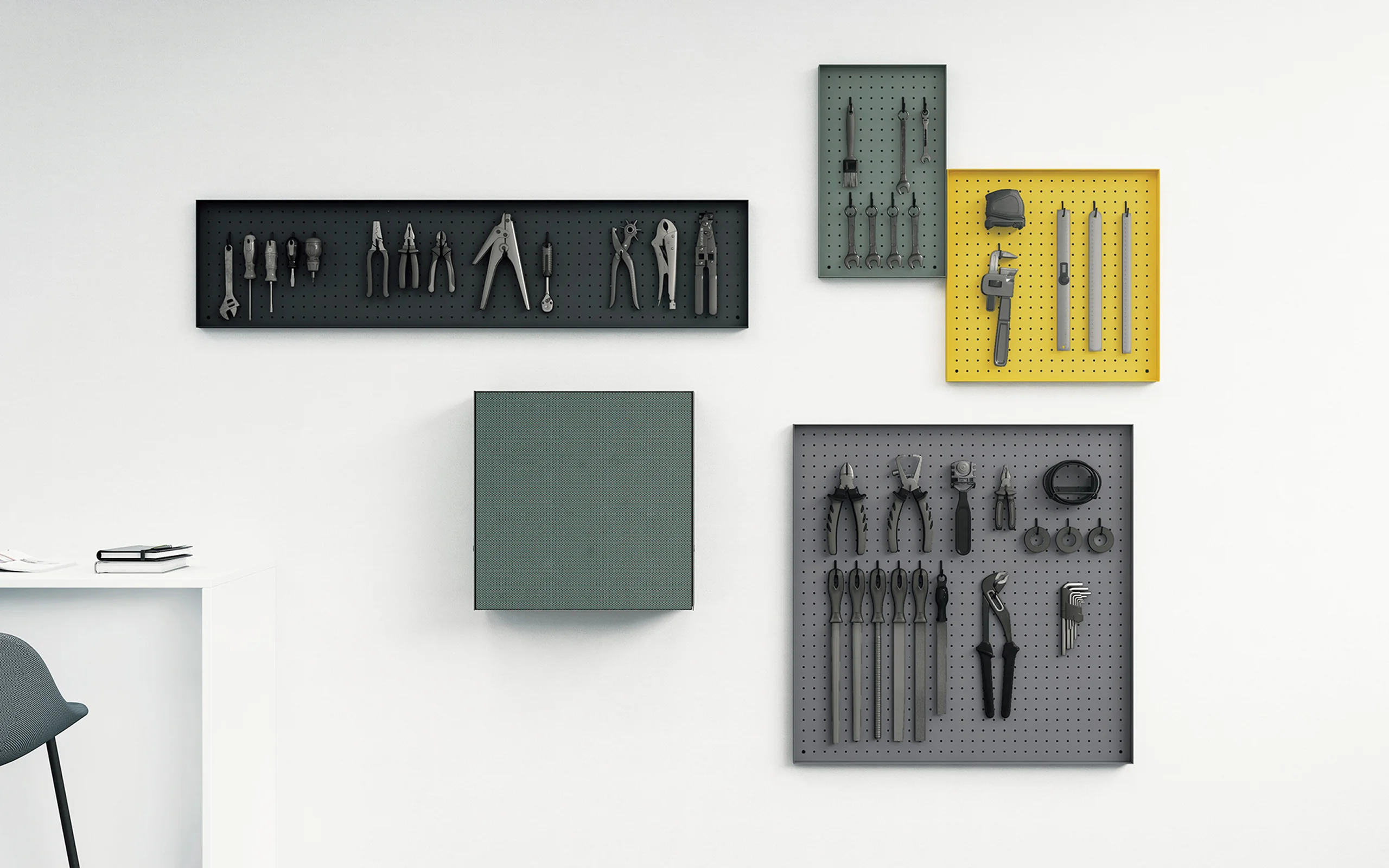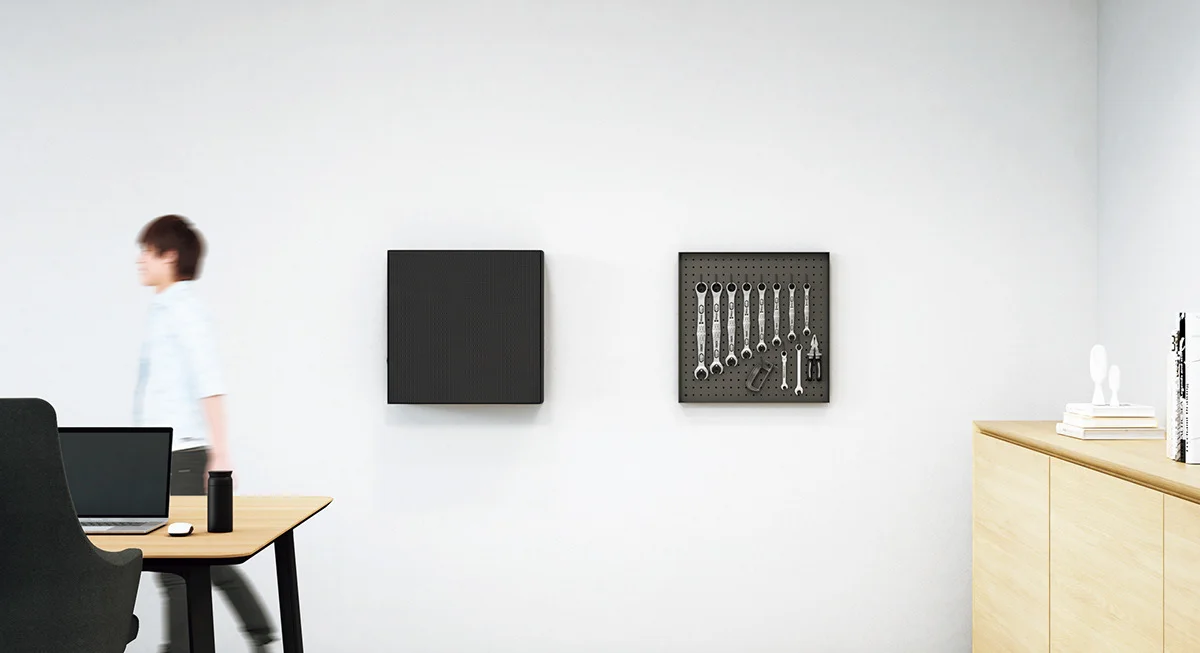
PROJECT
WAKERS
工具や作業台をアートのように配置でき、オフィスを創造的な空間にする新しい家具デザイン。

WHY
オフィスは本当に
創造の場になっているのか?
あらゆる仕事のルーツは、価値を創り出すことだったはずです。例えば、農家を表す「百姓」という言葉が、「百(多く)の仕事を持つ人」と解釈されるように、かつての人々は農作業の合間に木工、鍛冶、養蚕などさまざまな技術を用いて、日々の暮らしに必要なものを自らつくっていました。人々が「つくる」ことに根源的な喜びを感じるのは、数万年にわたる人の営みがもたらした本能なのでしょう。
職場で「創造性」を求められる頻度

「創造性」への障壁:国別の比較

しかし近代化によって仕事の分業化が進み、事務作業や管理業務など目に見える成果物を伴わない仕事が増えていきました。現代においては、人類学者のデヴィッド・グレーバーが「ブルシット・ジョブ」と呼んだような、価値が不明確で労働者自身も意義を感じられない仕事が少なくありません。
こうした環境下にある現代のオフィスワーカーは、創造性を発揮できる機会が限られてしまっています。仕事はPCのスクリーン上で完結することが多く、身体を伴った創造的行為を通して試行錯誤する「つくる場」は、効率性を重視した現代のオフィス空間から排除されているのが現状です。
近年のリモートワークの普及によってオフィスの存在価値すら揺らいでいる中、現代のオフィスが「創造の場」を取り戻すことは可能なのでしょうか。

HOW
創造力を目覚めさせる
アートのような道具収納。

WAKERSは、工具や文具をアートのようにオフィスに飾る、新しい道具収納家具です。オフィスの一人ひとりの創造力(makers mind)を目覚めさせる(wake)というコンセプトを、「MAKERS」(=つくる人たち)の頭文字「M」を上下に反転させたブランド名に込めました。
オフィス空間にはアートが飾られることがよくありますが、私たちはこうしたアートが持つ本来の力を、人の創造力を高めることと再定義し、働く環境において創造力を発揮するためのアートのような工具収納を設計しました。
「BOX」「WALL」と名付けられたWAKERSの2つの家具は、完成品のアート(=他者の創造)を飾る代わりに、自らの創造力を高める道具たちをアートのように収め、オフィス空間を真に創造的な場にする収納です。




BOXは、閉じている時にはまるでミニマル・アートのような存在感を示し、開くとすぐさまその場が作業台になる道具箱です。開閉の機構にカウンターウェイトを用いることで最小限の力でスムーズに工具にアクセスでき、開いた扉は作業台やカッターマットになります。薄さを追求した側面の板など細部の仕上げに徹底的にこだわることで、ミニマルでソリッドな形状が実現しました。

WALLは、まるで額装されたアート作品のように工具や文具を収納できる有孔ボードのフレームです。通常の有孔ボードよりも穴のピッチを狭めることで、作業道具がより際立って見えることが特徴です。穴のピッチは一般的な有孔ボードのちょうど半分に設定されているため、市販のあらゆる有孔ボード用のユニットが使用可能です。




WILL
自ら創造する社員が、生き残る会社をつくる。
人は誰しも生まれながらに創造性を持ち、何かを生み出すことに喜びを見出す生き物です。仕事や職場は、人生の中で長い時間を使う場所であり、私たちの創造性が最も本領を発揮できる環境であるべきでしょう。
WAKERSが目指しているのは、自ら手を動かし、発想を形にしやすい環境を整えることで、オフィスで働くすべての人がその創造性を躊躇なく発揮できる場をつくることです。歯車の一部として仕事をただ「こなす」のではなく、「つくる」ことへの意欲を持ち、創造的な仕事に挑む社員を増やすためのオフィスは実現できるはずです。創造的な空間があればこそ、組織は新たな価値を生み出し続けることができ、また個々の社員も自己実現を達成できるはずです。こうした健やかな創造の生態系を育むことで、これからの時代を生き残る会社づくりに貢献したいと考えています。
INFORMATION
- What
- WAKERS
- When
- 2024
- Where
- Japan
- Client
- Scope
- Design strategy / Product / Furniture
- Award
- GOOD DESIGN AWARD(2025)
- JID AWARD Shortlisted(2025)
CREDIT
- Art Direction
- NOSIGNER (Eisuke Tachikawa)
- Graphic Design
- NOSIGNER (Eisuke Tachikawa, Yuta Horimoto)
- Product Design
- NOSIGNER (Eisuke Tachikawa, Mahiro Kobayashi),
OKAMURA CORPORATION - CG Modeling
- NOSIGNER (Eisuke Tachikawa, Mahiro Kobayashi)
- Photograph